|
 Lachnellula rhopalostylidis Lachnellula rhopalostylidis
SynonymsArachnopeziza rhopalostylidis
BiostatusPresent in region - Indigenous. Endemic
Images (click to enlarge)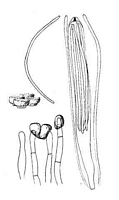
Caption: FIG. 15. Arachnopeziza rhopalostylidis. Habit sketch x 10, details x 660. | 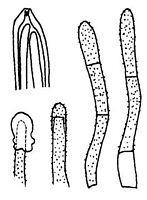
Caption: FIG. 1. Ascus apex, 4 hairs, x 1000. | 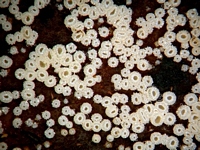
Caption: FUNNZ photo
Owner: J.A. Cooper | 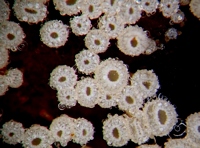
Caption: FUNNZ photo
Owner: J.A. Cooper | 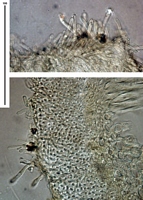
Caption: hairs and excipulum
Owner: J.A. Cooper | 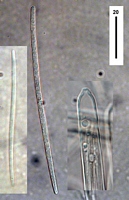
Caption: ascospores and ascus tip in Melzers
Owner: J.A. Cooper | 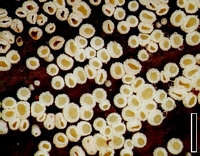
Caption: scale=1mm
Owner: J.A. Cooper |
Article: Dennis, R.W.G. (1961). Some inoperculate Discomycetes from New Zealand. Kew Bulletin 15(2): 293-320.
Notes: One may, perhaps, question the propriety of assigning to Arachnopeziza a fungus without a
visible subiculum. The apothecia, however, are densely crowded over extensive, sharply
defined, patches of the substrate, distinctly paler coloured than the remainder and must arise
from a common mycelial mat even if it does not form an evident subiculum. The fasciculate
ascospores, slender thin-walled hairs and cylindrical obtuse paraphyses all agree with
Arachnopeziza, though the spores do not appear to become septate in the asci. The
alternative genus without a subiculum would seem to be Lasiobelonium, the type species of
which, Belonidium amoenum Speg., is imperfectly known.
Article: Korf, R.P. (1977). Notes on Arachnopeziza fitzpatrickii and A. rhopalostylidis. Mycotaxon 6: 418-420.
Notes: Recently Dr. John H. Haines, New York State Museum, called to my attention a collection
taken by S. J. Hughes on 8. V. 1963 of Arachnopeziza rhopalostylidis Dennis (1961). Like
the type specimen, it was collected on dead leaves of Rhopalostylis sapida, a palm, and the
specimen (DAOM 156811) was obtained near the type locality, at Waiatarua, Waitakere
Range, Auckland Province, New Zealand. It is unquestionably the species described by
Dennis, and has densely gregarious apothecia totally devoid of a subiculum, with filiform
ascospores that remain non-septate for a long time (but, as shown to me by Dr. Haines,
eventually develop 1-3 septa). Dennis drew smooth hairs, but they are distinctly finely
granulate; some are thick-walled apically, others not; some are tipped by a resinous material.
The thick-walled asci have a tapering, J+ pore-wall (Dennis wrote, "apice ultimo obsolete
jodo coerulescente"). Significantly, the hyphae of the ascocarp are all long-celled and
glassywalled, bound in a gel (except for the loose hairs). This is no Arachnopeziza, and the
species must even fall outside of the Hyaloscyphoideae. It fits rather well within the concept
of the Trichoscyphelloideae (Korf, 1973), and since it differs only in minor respects from
species I now.range in Lachnellula Karst. emend. Dennis (inclusive of Trichoscyphella
Nannf.) I propose its transfer:
LACHNELLULA RHOPALOSTYLIDIS (Dennis) Korf, comb. nov.
Basionym: Arachnopeziza rhopalostylidis Dennis, Kew Bull. 15: 302. 1961.
Assignment of Dennis's species to Lachnellula is in keeping with the current, broad concept
of the genus, no longer restricted to spherical-spored species such as L. chrysophthalma
("Pers.") Karst. [= L. suecica (Fuckel) Nannf. in Lund. & Nannf.], but with the oval-spored
and filiform-spored species previously treated as members of Trichoscyphella. This
emendation by Dennis (1962) has been followed by such workers as Dharne (1965) and
Raltviir (1970). In its earlier, more restricted sense, the species assigned to the genus were
normally on coniferous hosts, but in its broader delimitation, hosts of many families occur.
Whether such anomalous species as L. theiodea (Cke. & Ell.) Sacc. (cfr. Korf, 1962) can still
be accommodated in the genus is open to serious doubt (Dennis, Dharne, and Raltviir, loc.
cit., all fail to mention this species). But quite clearly an interface exists betweeen the
Trichoscyphelloideae (with its one genus, Lachnellula) and species that have been placed in
the Phialeoideae, particularly in such genera as Cyathicula (inclusive of "Phialea," cfr
Dumont & Korf, 1977) and Belonioscypha, on the one hand, and species still ranged in
Dasyscyphus (in its broad sense) on the other. Whether L. rhopalostylidis needs to
segregated into some as yet undescribed genus will have to wait for further data. Information
on tropical members of the Hyaloscyphaceae currently being undertaken by Dr. Haines
should throw light on affinities in this group. But clearly the species cannot be
accommodated in Arachnopeziza, and its transfer out of the genus now at least calls attention
to its probable relatives.
|